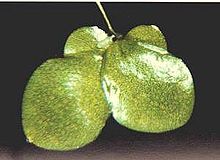Lemna gibba
| Lemna gibba | |
|---|---|

| |
| Scientific classification | |
| Kingdom: | |
| (unranked): | |
| (unranked): | |
| Order: | |
| Family: | |
| Subfamily: | |
| Tribe: | |
| Genus: | |
| Species: | L. gibba
|
| Binomial name | |
| Lemna gibba | |
Lemna gibba (gibbous duckweed[1] or fat duckweed) is a species of Lemna (duckweed) with distribution in temperate areas in Europe, including Britain, to the Himalayas, Africa, South America and North America. This duckweed is one of Britain's most common small water plants, which forms familiar green mats covering stagnant water bodies.[2] It has a simple plant body, known as a thallus, which floats on the surface of the water and measures up to five millimetres in diameter. A single root hangs down into the water. Found in a wide range of still or slow-flowing water bodies, common duckweed can also occur on mud or damp rocks.
Widespread throughout Britain, but is absent from much of Scotland and Shetland. Elsewhere the species has a very wide global distribution, absent only from polar areas and the tropics.[3]
You can view distribution information for this species on the Charms of Duckweed (worldwide) and National Biodiversity Network Gateway (Britain only).
This species spreads mainly through vegetative reproduction,[4] but flowers are occasionally produced in shallow water exposed to the full sun. When covering the entire surface of a pond, it can make the water appear solid, and in parts of the north-west of England children were scared away from such ponds by the myth of Jenny Green-teeth, a pond elf or monster whose presence was indicated by duckweed; she was said to lure children into ponds and drown them.[5]
References
- ^ Derived from the Latin, gibbus = hump, Merriam-Webster Online Dictionary
- ^ Mabey, R. (1996) Flora Britannica. Sinclair-Stevenson, London.
- ^ Clapham, A.R., Tutin, T.G. and Moore, D.M. (1987) Flora of the British Isles. 3rd Edition. Cambridge University Press, Cambridge.
- ^ Preston, C.D., Pearman, D.A. and Dines, T.D. (2002) The New Atlas of the British and Irish Flora. Oxford University Press, Oxford.
- ^ Grigson, G. (1996) The Englishman's Flora. Helicon, Oxford.
External links
- Lemna
- Aquatic plants
- Flora of Europe
- Flora of Asia
- Flora of Africa
- Flora of South America
- Flora of North America
- Flora of Canada
- Flora of the Eastern United States
- Flora of the Western United States
- Flora of Colorado
- Flora of the Sierra Nevada region (U.S.)
- Flora of the Rocky Mountains
- Flora of California chaparral and woodlands
- Flora of the California desert regions
- Flora of Central Mexico
- Flora of the Mediterranean
